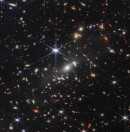After a grueling process, the JWST has finally been calibrated, and it has been making headlines with the images released in the last week. As expected, the Lagrange point orbit that this mighty telescope finds itself in provides a more than advantageous position for deep space imaging.
Webb's First Deep Field, which has received widespread interest and enthusiasm, contained an image of the galaxy cluster SMACS J0723.3–7327 in a region inside the Volans constellation.
With that being said, I urge you to prepare for the genuinely mind-blowing news this new space telescope brought us. Up to this point, the farthest galaxies previously known in our universe were GN-z11 and HD1. The name GN-z11 represents the fact that its redshift factor – or “z” – was 11. Scientists say it is about 400 million years younger than the universe itself. However, HD1 was discovered in April, and it has not managed to enjoy its record holder status for too long. Recently, images taken by the James Webb Space Telescope suggest that GLASS-z13 has been around for even longer, being an estimated 30 million years older than the previously discovered GN-z11.
We have passed the cusp of astounding discovery, and we’re looking at a celestial object that has been here for a brain-melting 13.5 billion years. Now, I know numbers like this are hard to comprehend. However, to give you some context, the universe was still just a jumbled-up, hot soup of particles when this galaxy first came into existence. Barely any stars or galaxies had formed.
The images require translation from infrared into the visible spectrum, and the end result of that process shows us the galaxy looking like a blob of red with white in its center, as part of a broader image of the distant cosmos called a "deep field." Even more impressive still is the fact that looking so far into the cosmos means that we’re looking at light that took an exceedingly long time to reach us, meaning we are literally looking back through time at how the universe was in its very beginning.
The JWST can achieve such wonders by being uniquely equipped to detect light that has been shifted to the infrared region of the light spectrum due to its wavelength being literally stretched by the universe's expansion.
With such of these capabilities, the scientists working on this stunning piece of engineering have high hopes of making new and phenomenal discoveries. One of the most exciting promises that the telescope makes is to find the earliest galaxies formed, with an age of approximately 13.8 billion years.
With that being said, I urge you to prepare for the genuinely mind-blowing news this new space telescope brought us. Up to this point, the farthest galaxies previously known in our universe were GN-z11 and HD1. The name GN-z11 represents the fact that its redshift factor – or “z” – was 11. Scientists say it is about 400 million years younger than the universe itself. However, HD1 was discovered in April, and it has not managed to enjoy its record holder status for too long. Recently, images taken by the James Webb Space Telescope suggest that GLASS-z13 has been around for even longer, being an estimated 30 million years older than the previously discovered GN-z11.
We have passed the cusp of astounding discovery, and we’re looking at a celestial object that has been here for a brain-melting 13.5 billion years. Now, I know numbers like this are hard to comprehend. However, to give you some context, the universe was still just a jumbled-up, hot soup of particles when this galaxy first came into existence. Barely any stars or galaxies had formed.
The images require translation from infrared into the visible spectrum, and the end result of that process shows us the galaxy looking like a blob of red with white in its center, as part of a broader image of the distant cosmos called a "deep field." Even more impressive still is the fact that looking so far into the cosmos means that we’re looking at light that took an exceedingly long time to reach us, meaning we are literally looking back through time at how the universe was in its very beginning.
The JWST can achieve such wonders by being uniquely equipped to detect light that has been shifted to the infrared region of the light spectrum due to its wavelength being literally stretched by the universe's expansion.
With such of these capabilities, the scientists working on this stunning piece of engineering have high hopes of making new and phenomenal discoveries. One of the most exciting promises that the telescope makes is to find the earliest galaxies formed, with an age of approximately 13.8 billion years.







